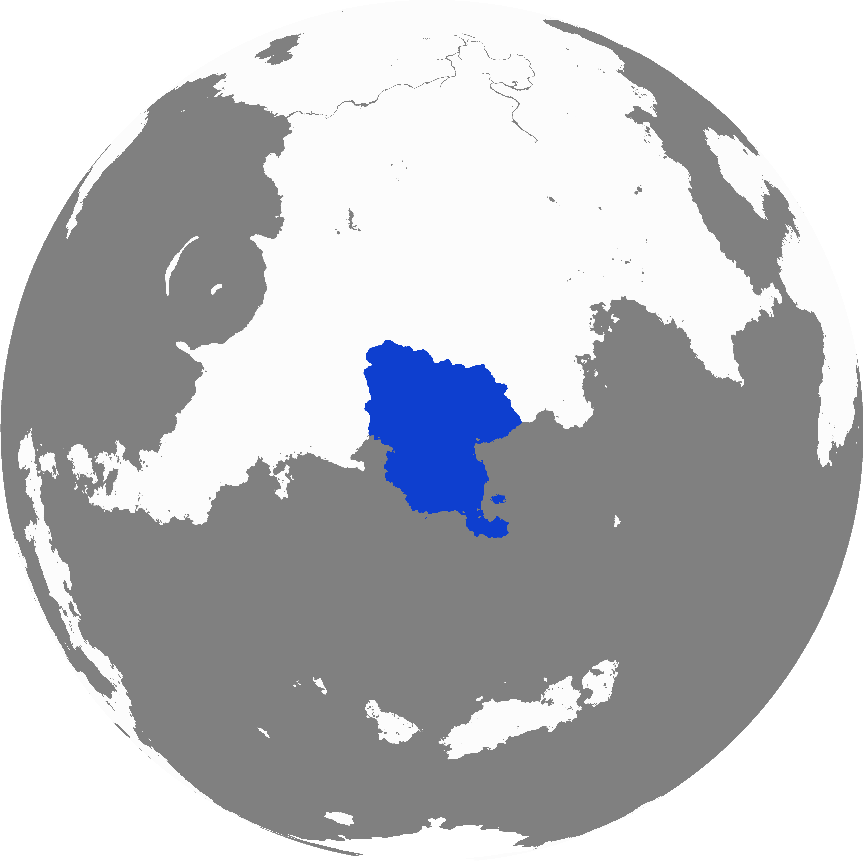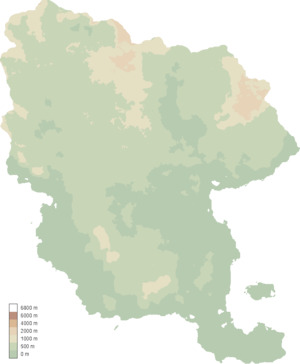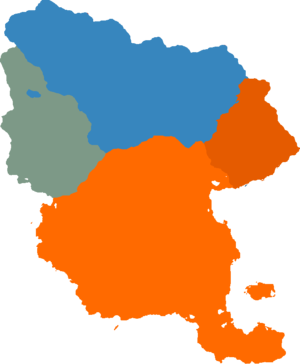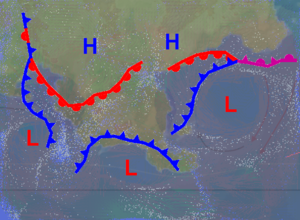Nuvastia: Difference between revisions
No edit summary |
mNo edit summary |
||
| Line 82: | Line 82: | ||
[[Category:KP2.5 Nations]] |
[[Category:KP2.5 Nations]] |
||
[[Category:KP2.3 Nations]] |
[[Category:KP2.3 Nations]] |
||
| + | |||
| + | |||
| + | {{Infobox country |
||
| + | |conventional_long_name = Nuvastian Sovereignty |
||
| + | |native_name = ''Nuvastia'' |
||
| + | |common_name = Nuvan |
||
| + | |image_flag = File:Nuvastian Sovereignty Flag Medium Ripple.png |
||
| + | |alt_flag = |
||
| + | |image_map = [[File:Nuvastia Formal Map 2.png|thumb|Nuvastian mainland map]] |
||
| + | |alt_map = |
||
| + | |image_map = {{switcher|[[File:WikiBall - Nuvastia.png|frameless]]|Show globe|[[File:WikiFlat - Nuvastia.png|frameless]]|Show map of Nuvastia|default=1}} |
||
| + | |national_motto = <br/>"Nam de fratribus tuum, ut vivere nobis"<br/>{{small|"For thy fellow countrymen, we live as one"}} |
||
| + | |national flag = |
||
| + | |national_anthem = <br/>[[File:Nuvastian Hymn Lite.mp3]] |
||
| + | |official_languages = {{hlist |Nuvan}} |
||
| + | |regional_languages = {{hlist |Nuvan |Vastian |Anderian |Iconian}} |
||
| + | |demonym = Nuvastian, Nuvan |
||
| + | |ethnic_groups = |
||
| + | {{unbulleted list |
||
| + | | [[Nuvan]] |
||
| + | | [[Vastian]] |
||
| + | | [[Anderian]] |
||
| + | | [[Iconian]] |
||
| + | }} |
||
| + | |capital = [[Nusas]] |
||
| + | |largest_city = [[Vlaka]] |
||
| + | |government_type = Democratic Republic |
||
| + | |leader_title1 = [[Head of State]] |
||
| + | |leader_name1 = [[Fausto Solomon]] |
||
| + | |leader_title2 = [[Head of Government]] |
||
| + | |leader_name2 = [[Chris Ravenfield]] |
||
| + | |legislature = [[The Nuvastian Government]] |
||
| + | |area_rank = ??th |
||
| + | |area_km2 = 449,168 |
||
| + | |area_sq_mi = 173,424.73 |
||
| + | |percent_water = 0.7 (inland waters) |
||
| + | |population_estimate = 35+ mil |
||
| + | |population_estimate_rank = ??th |
||
| + | |population_estimate_year = 2020 |
||
| + | |population_census = 35,112,458 million |
||
| + | |population_census_year = 2012 |
||
| + | |population_density_km2 = {{#expr:(35112458/449168 round 2)}} |
||
| + | |population_density_sq_mi = <!-- Autocalculated, leave blank! ---> |
||
| + | |population_density_rank = N/A <!--UN World Population Prospects--> |
||
| + | |GDP_nominal = $528 billion |
||
| + | |GDP_nominal_year = 2020 |
||
| + | |GDP_nominal_per_capita = {{increase}} ${{formatnum:{{#expr:(528000000000/35112458 round 3)}}}} |
||
| + | |sovereignty_type = Democratic Republic |
||
| + | |established_event1 = Declared |
||
| + | |established_date1 = 15 Feb 2020 |
||
| + | |established_event2 = Independence from Aquilia |
||
| + | |established_date2 = Year 474 |
||
| + | |established_event3 = Independence from Anderia |
||
| + | |established_date3 = Year 1915? |
||
| + | |HDI_year = |
||
| + | |HDI_change = decrease <!--increase/decrease/steady--> |
||
| + | |HDI = <!--number only--> |
||
| + | |HDI_ref = |
||
| + | |HDI_rank = |
||
| + | |Gini_year = |
||
| + | |Gini_change = steady <!--increase/decrease/steady--> |
||
| + | |Gini = <!--number only--> |
||
| + | |Gini_ref = |
||
| + | |Gini_rank = |
||
| + | |currency = [[Veds]] |
||
| + | |currency_code = VDS |
||
| + | |drives_on = right |
||
| + | |calling_code = |
||
| + | |electricity = |
||
| + | |cctld = [[.bd]] |
||
| + | }} |
||
| + | |||
| + | '''Nuvastia''' or officialy known as the '''Nuvastian Sovereignty''' [https://translate.google.com/?sl=en&tl=la&text=Nuvastian%20Sovereignty%0A&op=translate How Nuvastia is pronounced] is a nation located in a peninsula within the Serthenian continent also formerly known as Nuvastian Republic. Situated just under Eusonia and the just above the calm and breezy Nuvastian seas, the nation is a thriving amalgamation of four (4) primary cultures which affected its developments, namely Aquilians (modern day Iconians), Anderians, Nuvans and Vastians. |
||
| + | |||
| + | The country's landscape is both beautiful and harsh; cold, windy mountains, fresh rushing rivers and harsh desert lands are a sigth to behold. It has lots to offer, which is why the country is flocked and evaded upon among foreigners. |
||
| + | |||
| + | It has a very distinct biodiverse terrain which spans all throughout different terrains and climate within the nation. Nuvastia has resolute laws and law enforcement, which is quite normal. The people are peace-loving due to long lasting peace, thanks to everything they fought for. |
||
| + | |||
| + | __TOC__ |
||
| + | |||
| + | == General Information == |
||
| + | |||
| + | '''Nation Name:''' Nuvastia (Nuvastian Republic) |
||
| + | |||
| + | '''National Denonym:''' Nuvanian, Nuvan |
||
| + | |||
| + | '''National History:''' The Nuvanian Republic came from the local tribes and city-states established at the coasts and gained its independence through peaceful means. |
||
| + | |||
| + | == Government == |
||
| + | |||
| + | '''Government Type:''' Democtratic Republic |
||
| + | |||
| + | '''Head of State:''' Fausto Solomon (came from the current prevailing political dynasty) |
||
| + | |||
| + | '''Head of Government:''' Chris Ravenfield |
||
| + | |||
| + | '''Politics:''' There are two major parties inside the Republic, the '''Nuvastian National Party (NNP)''' and the '''Nuvastian Separatist Party (NSP)''' |
||
| + | |||
| + | == Overall Economy == |
||
| + | |||
| + | '''Economy:''' The Nuvanian economy is noted for its trade on an international scale. The economy relies on advanced material recycling technologies and methodologies, they are importers of recyclable materials and exporters of various goods being traded. They combine their resource output with the processed recycled materials. They also have minor farming operations scattered in the northern lands. They supply various kinds of food and resources from the seas surrounding them contributing to the global economy. |
||
| + | |||
| + | '''GDP:''' 528 745 548 120 Veds |
||
| + | |||
| + | '''GDP per capita:''' 15107 Veds |
||
| + | |||
| + | '''Currency Name:''' Veds |
||
| + | |||
| + | '''Economic System:''' Capitalist |
||
| + | |||
| + | '''Resources:''' Bountiful seafood, various metals and ores, vast amounts of recycled materials. Oil and natural gas beneath the seas. |
||
| + | National fish: is the Skia fish |
||
| + | |||
| + | '''Technology and Advancements:''' They are noted for their advances in recycling technologies and creating robust & resilient structures both for industrial, civilian and military applications. Farming technologies includes mass soil hydration and revivification. Privatized research operations. |
||
| + | |||
| + | '''Cities and National Assets:''' |
||
| + | |||
| + | '''The capital city of Nusas''' is located at the east serves as the nation’s center of prominence where authority is derived and where most important administrative decisions take place. It’s famous for its great buildings and historical landmarks. |
||
| + | |||
| + | '''Major port cities of Ragos and Amburg''' provide the nation with access to the surrounding western and southern seaboard for foreign trade and commerce. These cities focus primarily on manufacturing and processing assorted imports and exports, they also cater to major military naval installations, the Nuvastian navy and coastguard ships are frequently seen docked on their ports and they are valued as of great strategic importance. '''Ragos''' also has access to refineries together with vast ore and crystal mines just outside the city. Lots of supply depots are found around these cities. |
||
| + | |||
| + | '''Minor port cities of Apantha, Slario, Vlaka and Nusas''' mainly accommodate various seagoing vessels like cargo ships, passenger ships, fishing vessels and fuel tankers. These cities have access to the western seaboard, '''Port Halsey Island''' and extending all throughout to the '''Etanamic Ocean'''. '''Vlaka''' is considered the '''“financial center”''' of Nuvastia and is comfortably situated between two seaboards and near the capital for ease of access and serves as the center of corporate and industrial exchange, lots of business centers can be found here for logistical purposes. All these major and minor port cities have facilities and infrastructure to tend different ships of all kinds and sizes, shipyards and dry-docks could be seen near the shorelines assembling ships to supply the ever-growing needs of the nation. Harbors continually receive ocean liners and luxury cruise ships and they frequently load and unload passengers from all over the world. |
||
| + | |||
| + | '''Industrial cities of Velgas, Ingrith and Ipento''' provide the nation with much needed food supply and industrial processing capacity. These cities are surrounded by large tracks of farmlands that provide the nation with a steady supply of different food sources such as crops and animals from the rich lush fields of the Nuvastian mainland. These three cities are dubbed as the '''“crossroad cities”''' of Nuvastia which is invaluable to the overall economic prosperity. A lot of Nuvastians flock to these cities for opportunities and are highly urbanized and commercialized; factories are well spread out near these cities. |
||
| + | |||
| + | The city of '''Agoby''' is the center of research and development and is noted for its advances in modern technology for the development of the young nation. Prestigious academies are located here together with tech startups and laboratories. Heavy military research facilities are mostly located near or around the city. The cities of Agoby and Ipento provide the nation with the much needed electric power coming mostly from fuel plants and small nuclear power plants. Although other minor sources of energy include mostly solar and tidal energy. |
||
| + | '''Minor cities of Osastin and Arcburgh''' although small, offer great living conditions for the common Nuvastian as these “border cities” usually have a high number of foreigners. |
||
| + | |||
| + | [[File:Nuvastia Formal Map 3.png|thumb|Map of Nuvastia, Major cities and towns]] |
||
| + | |||
| + | |||
| + | === Trade and Transit: === |
||
| + | The nation's seashores are filled with busy industrial seaports; foreigners are routinely seen going in and out of the nation. Passenger and cargo ships fill the Nuvastian shorelines along with container and tanker ships. Fishing vessels supply the nation with fresh bounty from the southern seas. Major trading partner includes Iconia and surrounding neighbor nations. |
||
| + | |||
| + | [[File:Iconian Routes.png|thumb|Nuvastian-Iconian Routes]] |
||
| + | |||
| + | === Corporations & Companies === |
||
| + | The dominant media outlet is the '''Nuvastian News Network (NNN)''' which also includes the '''Nuvastian National Newspaper (NNN)'''. Foreign corporations from Iconia include the NRF (???) they manufacture industrial and military ships for the Nuvastian naval needs and supplies various components while the RS (Royal Gessian) caters to civilian needs such as public ferries and luxury oceanliners. In this list are the major and minor companies and corporation which includes the following: |
||
| + | {| |
||
| + | |- |
||
| + | |'''1 Special Seed Company'''[[File:Special Seed.png|200px|thumb|center|Special Seed Company Logo]] |
||
| + | |'''2 Solaire Systems Power Company'''[[File:Solaire Systems.png|150px|thumb|center|Solaire Systems Power Company Logo]] |
||
| + | |- |
||
| + | |'''3 Sustainable Sun Power Corporation'''[[File:Sustainable Sun.png|150px|thumb|center|Sustainable Sun Power Corporation Logo]] |
||
| + | |'''4 Steel Society Mining Corporation'''[[File:Steel Society A.png|150px|thumb|center|Steel Society Old Logo]] |
||
| + | | [[File:Steel Society B.png|150px|thumb|center|Steel Society New Logo]] |
||
| + | |- |
||
| + | |'''5 Sprint Shipping Corporation'''[[File:Sprint Shipping.png|150px|thumb|center|Sprint Shipping Corporation Logo]] |
||
| + | |'''6 Slimy Stone Corporation'''[[File:Slimy Stone.png|150px|thumb|center|Slimy Stone Corporation Logo]] |
||
| + | |'''7 Secret Stash Banking and Finance'''[[File:Secret Stash.png|150px|thumb|center|Secret Stash Banking and Finance Logo]] |
||
| + | |- |
||
| + | |'''8 Small Semiconductors Corporation'''[[File:Small Semiconductors.png|150px|thumb|center|Small Semiconductors Corporation Logo]] |
||
| + | |'''9 Soaring Sky Industries'''[[File:Soaring Sky.png|150px|thumb|center|Soaring Sky Industries Logo]] |
||
| + | |'''10 Spacescope Aerospace Enterprise'''[[File:SpaceScopeA.png|150px|thumb|center|Spacescope Aerospace Enterprise Logo]] |
||
| + | |} |
||
| + | |||
| + | == Demographics and Culture == |
||
| + | |||
| + | '''Population:''' 35,112,458 (2012 Census) |
||
| + | |||
| + | '''Official Language:''' Vastian |
||
| + | |||
| + | '''List Regional Languages:''' Nuvan and Vastian |
||
| + | |||
| + | '''National/State religion:''' ?Undocumented? |
||
| + | |||
| + | Short Description of Culture: The Nuvanian population is growing at unprecedented rate due to 4 child policy being enforced by the government. People living in the north are called Nuvans and those in the south are Vastians. Nuvans are dominant compared to the Vastians, who are predominantly the working class. |
||
| + | |||
| + | == Geography & Terrain == |
||
| + | The nation is one big peninsula, famous for its lush and thick forests and low mountains. The notable southern Nuvastian sea is rich in natural resources. Though surrounded by large bodies of water, north east of Nuvastia is somewhat dry arid lands and some close to desert terrain. |
||
| + | [[File:Nuvastian DATA MAP L small 3.png|thumb|Nuvastian Peninsula weather patterns]] |
||
| + | === Climate & Weather === |
||
| + | It has only two seasons wet and dry, the nation is often subjected to fierce weather systems when its transitioning between seasons, most storms come from the eastern seaboard. Storm surges and typhoons are very frequent during its wet season. |
||
| + | |||
| + | == Military == |
||
| + | |||
| + | Mandatory 5 year service. |
||
| + | |||
| + | '''Active Personnel:''' 50,000 |
||
| + | |||
| + | '''Reserve Personnel:''' 250,000 |
||
| + | |||
| + | '''Total:''' 300,000 |
||
| + | |||
| + | '''Military Spending as 4% of GDP:''' 21 149 821 925 € |
||
| + | |||
| + | {| class="wikitable" style="text-align: center; width: 200px; height: 200px;" |
||
| + | |+ Table |
||
| + | |- |
||
| + | ! X |
||
| + | ! Army |
||
| + | ! Marines |
||
| + | ! Navy |
||
| + | ! Coastguard |
||
| + | ! Airforce |
||
| + | ! Spaceforce |
||
| + | |- |
||
| + | ! Budget |
||
| + | | 1 || 2 || 3 || 4 || 5 || 6 |
||
| + | |- |
||
| + | ! Personnel |
||
| + | | 2 || 4 || 6 || 8 || 10 || 12 |
||
| + | |- |
||
| + | |} |
||
| + | |||
| + | == History: Full timeline with brief historical highlights == |
||
| + | |||
| + | '''2000 -> 2020''' |
||
| + | |||
| + | '''Year 2000s and onward:''' Eventually peace was settled without passing through a civil war, laws were passed and enacted after some minor conflicts and economic concessions, certain agreements and adaptations by both sides lead to the eventual merging of the name Nuvan and Vastian hence Nuvastian. In essence the Nuvastian demographics includes Aquilian (Iconian) and Anderian (Vastian) descendants. |
||
| + | |||
| + | '''Contemporary 1900 -> 2000''' |
||
| + | |||
| + | '''Year 1965:''' After the Great War, Nuvastia was able to gain independence after the foreign Anderian influence and support was waning over time. Rebellious uprising sporadically emerged and the colonizers weren’t able to quell the southern coastal cities and towns. Combined with the after effects of the Great War and lack of proper administrative support in the province, a great racial tension emerged between the Nuvans and the Anderians, the Nuvans up north named the southerner Anderians as the Vastians, a derogatory term for being a working class that came from the vast seas down south. Eventually the Nuvans up north became the ruling class and the Vastians being subservient to them. |
||
| + | |||
| + | '''Year 1934:''' Due to economic pressures put on by the war, Nuvastians started boycotting major industries focused on sending war materials towards Anderia. Major corporations started to employ mercenaries (private security contractors) to protect their business assets on Nuvastia but later on they joined in against sending resources to the Anderians. They started to gain Anderian turncoat support as they were mainly protecting the merchant shipping lines. The Nuvastians were left off to themselves, as such there was nothing much they could do as ships in trade and transit were being sunk left and right. Overall naval traffic was reduced, Anderian captains refused to go out at sea. |
||
| + | |||
| + | '''Year 1922 to 1925:''' Anderia was gaining and winning the war |
||
| + | |||
| + | '''Year 1924:''' Kerthenia and Serria prepared for war and the Anderian war economy was recovering while submarine attacks continued on Serrian seas. (Which lessened the attacks on Nuvastian shipping lines?) |
||
| + | |||
| + | '''Year 1923:''' Anti-Kerthenian Dolphik shipping raids started and submarine attacks on merchant ships become rampant, this included Nuvastian shipping lines being targeted. |
||
| + | |||
| + | '''Year 1921:''' First Kerthenian ship was sunk by the Dolphiks, started |
||
| + | |||
| + | '''Year 1920-1922:''' Due to extreme economic pressures put on by the war, Nuvastians started boycotting major industries focused on sending war materials to Anderia. These industries put a lot of strain on the Nuvastian economy that people were in open revolt against the Anderian authorities running the economy. Conditions were unbearable that basic resources became scarce frequent worker strikes were a common sight. |
||
| + | |||
| + | '''Year 1918 to 1920:''' Dolphiks started major offensives into Anderian territory, this led to the active enforcement of the Anderian demands upon the Nuvastian economy hereby requiring the nation to send resources to the Anderians but just after a few years the nation showed major signs that it was losing the war on all fronts despite all its efforts. |
||
| + | |||
| + | '''Year 1917 to 1935:''' The Great War happened and lasted from 1917 to 1934 fought between Dolfikland, Yinshan, Heruland, Ostreich vs Anderia, Orbs, Cadenza , Kerthenia, Eusonia, etc. The Nuvastian peninsula was rather isolated during this time allowing the Nuvastian economy to grow. Nuvastia became wealthy as it grew relatively unharmed enabling the isolated nation to develop even while under Anderian control and influence. |
||
| + | |||
| + | '''Late Modern age 1800 -> 1900''' |
||
| + | '''Early 1850s to 1950s:''' Due to the advent of heavy industrialization of the nation, pollution issues started to arise. |
||
| + | |||
| + | '''Late Modern age 1700 -> 1800''' |
||
| + | 1781 and 1792 Kerthenia and Qusmos gained independence |
||
| + | |||
| + | '''Early Modern age 1600 -> 1700''' |
||
| + | '''16th and 17th Century:''' The Nuvastian Peninsula became an Anderian colony, wherein they established trading and farming colonies between the 1600s and late 1700s, they occupied the area and political authority was concentrated in the coastal cities and trading ports. |
||
| + | |||
| + | '''Early Modern age 1500 -> 1600''' |
||
| + | '''Late 1600s:''' Anderians have established ports and harbors on the shores of Nusas and established trading platforms in which ships could dock at will. |
||
| + | |||
| + | '''Modern Age (1500-present) 1500 to around c. 1800''' |
||
| + | |||
| + | '''Late Middle Ages 1400 -> 1500''' |
||
| + | No content: |
||
| + | |||
| + | '''Middle Ages/Medieval Period: High 1300 -> 1400''' |
||
| + | No content: |
||
| + | |||
| + | '''Middle Ages/Medieval Period: High 1200 -> 1300''' |
||
| + | No content: |
||
| + | |||
| + | '''Middle Ages/Medieval Period: High 1100 -> 1200''' |
||
| + | No content: |
||
| + | |||
| + | '''Middle Ages/Medieval Period: High 1000 -> 1100''' |
||
| + | No content: |
||
| + | |||
| + | '''Middle Ages or Medieval Period (High, 1000 and 1347)''' |
||
| + | No content: |
||
| + | |||
| + | '''Middle Ages/Medieval Period: Early 900 -> 1000''' |
||
| + | No content: |
||
| + | |||
| + | '''Middle Ages/Medieval Period: Early 800 -> 900''' |
||
| + | '''8th to 15th century:''' The “Golden years of Nuvastia”, lots of development occurred under the former influence of the Aquillians, allowing the Nuvastians to govern themselves uninterrupted. |
||
| + | |||
| + | '''Middle Ages/Medieval Period: Early 700 -> 800''' |
||
| + | '''Early 700s:''' The original Aquilians (Iconians) have been assimilated with the local Nuvanians through the centuries of time. There was a small demographic change due to assimilation between the Aquilians and the local people during the 4th to 7th century, from which they became Serthenian in traditions and outlook. Language-wise, they have taken some form of Serthenian dialect as their own after the split during the 7th century. |
||
| + | |||
| + | '''Middle Ages/Medieval Period: Early 600 -> 700''' |
||
| + | '''Late 600s:''' Aquillians have kept friendly terms with its former cities, slowly and loosely letting the Nuvanians take care of themselves. Regular trade and transit resumed up until the early 700s. |
||
| + | |||
| + | '''Year 630s:''' Nuvastians had become self-sustaining. They learned self-sufficiency and became independent from the Aquillians. |
||
| + | |||
| + | '''Year 625:''' The Aquilians returned to Nuvastia and tried to quell dissent upon the local population. The civil war was not over and they tried their focus on reclaiming and restoring order to the cities. Aquillian ships were sent back and tried to subdue cities that were in open revolt against the mainland. Some towns and cities accepted their demands but the majority didn’t and were under the control of the Nuvanian separatists. Aquillian influence was dwindling and most of the Aquillians that already settled there, supported their fight for independence. Fighting and hostilities continued as they tried to return to the Nuvastian peninsula. There were moments when both sides tried to establish peace as the infighting always led to stalemate for both sides. |
||
| + | |||
| + | '''Year 613:''' Governmental problems erupt as civil unrest rose to an all time high and the Aquillians struggled to take control of its major holdings in the peninsula due to strains put on by the Nuvastians. Rallies on the streets are a common sight. |
||
| + | |||
| + | Middle Ages/Medieval Period: Early 500 -> 600 |
||
| + | '''Year 532:''' Early underground nuvastian dissident organizations formed to confront established Aquilian authority, and openly began minor incursions against them. |
||
| + | |||
| + | '''Year 517-518:''' The Aquilian civil war begins, demanding war conditions forced the Aquillians to use every available ship at their disposal, most ships essential used for trade and transit were called back to be utilized for the Aquillian islands. Combat ships were used for the war effort extensively. This in turn cut the contact with the Nuvanians and all proceeding ship traffic halted until 625. Aquillian authorities in the Nuvanian Peninsula were left to themselves without proper aid from their motherland. |
||
| + | |||
| + | '''Middle Ages or Medieval Period (500 -> 1500)''' |
||
| + | |||
| + | '''Ancient History 400 -> 500''' |
||
| + | '''Late 4th and early 5th century:''' Due to the developments made by the Nuvans and interaction with the mainland Iconia the main Aquillian economy was slightly displaced. (from this point on Aquilians and slaves living there were referred to as Nuvanians) |
||
| + | |||
| + | '''4th century:''' At the beginning of the early 4th century, most of the nuvastian shores lands are now in control of the Aquillian colonizers and Nuvastian society was forever changed. They developed town communities into small cities in such a short time, shore and inland settlements became established city-states. It became recognized by the Aquilians as Provincia Nusqua (in Aquillian language translates to “nowhere”) a province of Aquillia and was integrated into the Aquillian commerce, merchants and traders were well recognized as they export to Aquillians exotic goods like fast horses (which were only in draught breed on the islands) or other foods (such as the skia fish exclusively found on Nuvastian seas), exotic materials. |
||
| + | |||
| + | '''Ancient History 300 -> 400''' |
||
| + | |||
| + | '''Year 332 to 375:''' The Nuvastian '''“Years of Strife”''', The bulk of the Aquillian ships began landing on Nuvastian beaches near the shorelines of Amburg, although there were multiple earlier expeditions for the peninsula. The foreigners discovered and sought viable lands to establish footholds and met the early nuvastian tribes. As the Aquillians were prospecting lands and gathering resources, it led to early territorial struggles with the indigent local tribes which eventually led to an all out conflict with the natives. It was well documented that the Aquillians fought for territories and resisted the local tribes slowly making their way up north in the mainland center of the peninsula, they eventually won due to superior tactics and technological advantages. Nuvastian chieftains and their descendants united the tribes and fought bravely against their common enemy but most of the existing nuvastian society has been ravaged and most of their structures taken. Aquillian colonizers kept pouring in and made their own settlements and often occupied communities owned by the Nuvastians as they made other headways on other southern beaches ships and established other colonies. Tribe remnants who did not fight have traded with the Aquillians and made appropriate arrangements in coexisting together peacefully, they thrived well unlike their counterpart tribes due to access to top quality goods. |
||
| + | [[File:Aquilian Kingdom.png|400px|thumb|right|Aquillian Kingdom extent of colonization (Year 332 to 375)]] |
||
| + | {{CSS image crop |
||
| + | |Image = Aquilian Kingdom.png |
||
| + | |bSize = 800 |
||
| + | |cWidth = 400 |
||
| + | |cHeight = 400 |
||
| + | |oTop = 50 |
||
| + | |oLeft = 80 |
||
| + | |Location = right |
||
| + | |Description = Aquillian shore colonies (Year 332 to 375) |
||
| + | }} |
||
| + | '''Ancient History 200 -> 300''' |
||
| + | |||
| + | '''Year 290s:''' Nuvastian northern communities grew exponentially after integrating southern tribes into their own. Primitive forms of the societal caste system formed, and they were ranked according to level of importance, first were the teachers (priests), second were warriors and rulers, third were the farmers along with traders/merchants and fourth were the Laborers. Early road and communication systems were used in organizing their society, they developed primitive boats for exploring their shorelines and for fishing. Early written records showed they had sightings and made contact with foreign people coming from the seas and northern lands. |
||
| + | Year 240s: Multiple northern tribes organized themselves under one chieftain and started fighting and assimilating the southern tribes into their own. They looted the south for their abundance of food and resources and due to shortages brought by a long dry-spell between the 230s up to 241. |
||
| + | |||
| + | '''Year 210s:''' local tribes established small farming, hunting and fishing communities along bountiful rivers near the shorelines. Forests were often reserved for hunting and served as reserves for the small communities. Entire tribes formed communities along river banks and other hospitable locations available each numbering from 500 to 900+ people. They developed early housing structures and primitive medicine and followed common laws. They established tribe leaders that followed traditional familial lineages and continued them whenever they can. |
||
| + | |||
| + | '''Ancient History 100 -> 200''' |
||
| + | |||
| + | '''Year 180 to 190s:''' Early nuvastian tribes have vastly spread out all throughout the peninsula, tribal groups have established their own general areas of migration and movement but are constantly in contact with other far-off tribes. |
||
| + | |||
| + | '''Ancient History 0 -> 100''' |
||
| + | No historical records: |
||
| + | |||
| + | '''Ancient History -100 -> 0''' |
||
| + | No historical records: |
||
| + | |||
| + | '''Ancient History -200 -> -100''' |
||
| + | |||
| + | '''Year -260s:''' Nuvastian tribes have roughly covered and explored one-half of the Peninsula. |
||
| + | |||
| + | '''Ancient History -300-> -200''' |
||
| + | No historical records: |
||
| + | |||
| + | '''Ancient History -400 -> -300''' |
||
| + | No historical records: |
||
| + | |||
| + | '''Ancient History -500 -> -400''' |
||
| + | |||
| + | '''Year -550s:''' Nuvastian tribes have roughly covered and explored one-fourth of the Peninsula. |
||
| + | |||
| + | '''Ancient History -600 -> -500''' |
||
| + | No historical records: |
||
| + | |||
| + | '''Ancient History -700 -> -600''' |
||
| + | No historical records: |
||
| + | |||
| + | '''Ancient History -800 -> -700''' |
||
| + | |||
| + | '''Year -820s:''' local tribes live off the land as hunter-gatherers and scavengers. They migrate from one place to another using beasts of burden to carry hunting and housing materials from one place to another constantly seeking greener pastures depending on the season. Most animals available as food had migration routes that the tribes followed. |
||
| + | |||
| + | '''Ancient History -900 -> -800''' |
||
| + | No historical records: |
||
| + | |||
| + | '''Ancient History -1000 -> -900''' |
||
| + | No historical records: |
||
| + | |||
| + | |||
| + | '''Ancient History (-3600 -> 500)''' |
||
| + | |||
| + | ==Notes== |
||
| + | {{reflist|group=note}} |
||
| + | |||
| + | |||
| + | [[Category:Countries on Kerbin]] |
||
Revision as of 18:53, 4 December 2021
https://wiki.kerbin.org/index.php?title=Nuvastia
|
The Temple State of Ato
Tempelato
|
|||||
|---|---|---|---|---|---|
 |
|||||
| Motto | "ad astra per aspera" | ||||
| Common Name | Nuvastia | ||||
| Anthem | "Kevin MacLeod - Groove Grove" | ||||
 |
|||||
| Denonym | Temporary | ||||
| Official languages | Tempal | ||||
| Currency | Cash | ||||
| Politics | |||||
| Capital | Nusas | ||||
| Government | Unitary Single Party State | ||||
| Foundation | 2021 | ||||
| Preceded by | n/a | ||||
| Followed by | n/a | ||||
| Demography | |||||
| Ethnicities | 60% Temple 40% Church |
||||
| Population | 0.6 Million | ||||
| Area | 69'420 km² km² | ||||
Etymology
###
Geography
###
Climate
###
Biodiversity
###
Urban Areas
###
Politics
Government
###
Subdivisions
###
Foreign Relations
###
Demographics
Languages
###
Education
###
Religion
###
Age
###
Military
Air Corp
###
Army
###
###
Orbcom
###
Economy
Taxation
###
Transport
###
Energy and Infrastructure
###
Trade
###
Science
###
History
###
Notable Events
About The Flag
Nuvastia or officialy known as the Nuvastian Sovereignty How Nuvastia is pronounced is a nation located in a peninsula within the Serthenian continent also formerly known as Nuvastian Republic. Situated just under Eusonia and the just above the calm and breezy Nuvastian seas, the nation is a thriving amalgamation of four (4) primary cultures which affected its developments, namely Aquilians (modern day Iconians), Anderians, Nuvans and Vastians.
The country's landscape is both beautiful and harsh; cold, windy mountains, fresh rushing rivers and harsh desert lands are a sigth to behold. It has lots to offer, which is why the country is flocked and evaded upon among foreigners.
It has a very distinct biodiverse terrain which spans all throughout different terrains and climate within the nation. Nuvastia has resolute laws and law enforcement, which is quite normal. The people are peace-loving due to long lasting peace, thanks to everything they fought for.
General Information
Nation Name: Nuvastia (Nuvastian Republic)
National Denonym: Nuvanian, Nuvan
National History: The Nuvanian Republic came from the local tribes and city-states established at the coasts and gained its independence through peaceful means.
Government
Government Type: Democtratic Republic
Head of State: Fausto Solomon (came from the current prevailing political dynasty)
Head of Government: Chris Ravenfield
Politics: There are two major parties inside the Republic, the Nuvastian National Party (NNP) and the Nuvastian Separatist Party (NSP)
Overall Economy
Economy: The Nuvanian economy is noted for its trade on an international scale. The economy relies on advanced material recycling technologies and methodologies, they are importers of recyclable materials and exporters of various goods being traded. They combine their resource output with the processed recycled materials. They also have minor farming operations scattered in the northern lands. They supply various kinds of food and resources from the seas surrounding them contributing to the global economy.
GDP: 528 745 548 120 Veds
GDP per capita: 15107 Veds
Currency Name: Veds
Economic System: Capitalist
Resources: Bountiful seafood, various metals and ores, vast amounts of recycled materials. Oil and natural gas beneath the seas. National fish: is the Skia fish
Technology and Advancements: They are noted for their advances in recycling technologies and creating robust & resilient structures both for industrial, civilian and military applications. Farming technologies includes mass soil hydration and revivification. Privatized research operations.
Cities and National Assets:
The capital city of Nusas is located at the east serves as the nation’s center of prominence where authority is derived and where most important administrative decisions take place. It’s famous for its great buildings and historical landmarks.
Major port cities of Ragos and Amburg provide the nation with access to the surrounding western and southern seaboard for foreign trade and commerce. These cities focus primarily on manufacturing and processing assorted imports and exports, they also cater to major military naval installations, the Nuvastian navy and coastguard ships are frequently seen docked on their ports and they are valued as of great strategic importance. Ragos also has access to refineries together with vast ore and crystal mines just outside the city. Lots of supply depots are found around these cities.
Minor port cities of Apantha, Slario, Vlaka and Nusas mainly accommodate various seagoing vessels like cargo ships, passenger ships, fishing vessels and fuel tankers. These cities have access to the western seaboard, Port Halsey Island and extending all throughout to the Etanamic Ocean. Vlaka is considered the “financial center” of Nuvastia and is comfortably situated between two seaboards and near the capital for ease of access and serves as the center of corporate and industrial exchange, lots of business centers can be found here for logistical purposes. All these major and minor port cities have facilities and infrastructure to tend different ships of all kinds and sizes, shipyards and dry-docks could be seen near the shorelines assembling ships to supply the ever-growing needs of the nation. Harbors continually receive ocean liners and luxury cruise ships and they frequently load and unload passengers from all over the world.
Industrial cities of Velgas, Ingrith and Ipento provide the nation with much needed food supply and industrial processing capacity. These cities are surrounded by large tracks of farmlands that provide the nation with a steady supply of different food sources such as crops and animals from the rich lush fields of the Nuvastian mainland. These three cities are dubbed as the “crossroad cities” of Nuvastia which is invaluable to the overall economic prosperity. A lot of Nuvastians flock to these cities for opportunities and are highly urbanized and commercialized; factories are well spread out near these cities.
The city of Agoby is the center of research and development and is noted for its advances in modern technology for the development of the young nation. Prestigious academies are located here together with tech startups and laboratories. Heavy military research facilities are mostly located near or around the city. The cities of Agoby and Ipento provide the nation with the much needed electric power coming mostly from fuel plants and small nuclear power plants. Although other minor sources of energy include mostly solar and tidal energy. Minor cities of Osastin and Arcburgh although small, offer great living conditions for the common Nuvastian as these “border cities” usually have a high number of foreigners.
Trade and Transit:
The nation's seashores are filled with busy industrial seaports; foreigners are routinely seen going in and out of the nation. Passenger and cargo ships fill the Nuvastian shorelines along with container and tanker ships. Fishing vessels supply the nation with fresh bounty from the southern seas. Major trading partner includes Iconia and surrounding neighbor nations.
Corporations & Companies
The dominant media outlet is the Nuvastian News Network (NNN) which also includes the Nuvastian National Newspaper (NNN). Foreign corporations from Iconia include the NRF (???) they manufacture industrial and military ships for the Nuvastian naval needs and supplies various components while the RS (Royal Gessian) caters to civilian needs such as public ferries and luxury oceanliners. In this list are the major and minor companies and corporation which includes the following:
| 1 Special Seed Company | 2 Solaire Systems Power Company | |
| 3 Sustainable Sun Power Corporation | 4 Steel Society Mining Corporation | |
| 5 Sprint Shipping Corporation | 6 Slimy Stone Corporation | 7 Secret Stash Banking and Finance |
| 8 Small Semiconductors Corporation | 9 Soaring Sky Industries | 10 Spacescope Aerospace Enterprise |
Demographics and Culture
Population: 35,112,458 (2012 Census)
Official Language: Vastian
List Regional Languages: Nuvan and Vastian
National/State religion: ?Undocumented?
Short Description of Culture: The Nuvanian population is growing at unprecedented rate due to 4 child policy being enforced by the government. People living in the north are called Nuvans and those in the south are Vastians. Nuvans are dominant compared to the Vastians, who are predominantly the working class.
Geography & Terrain
The nation is one big peninsula, famous for its lush and thick forests and low mountains. The notable southern Nuvastian sea is rich in natural resources. Though surrounded by large bodies of water, north east of Nuvastia is somewhat dry arid lands and some close to desert terrain.
Climate & Weather
It has only two seasons wet and dry, the nation is often subjected to fierce weather systems when its transitioning between seasons, most storms come from the eastern seaboard. Storm surges and typhoons are very frequent during its wet season.
Military
Mandatory 5 year service.
Active Personnel: 50,000
Reserve Personnel: 250,000
Total: 300,000
Military Spending as 4% of GDP: 21 149 821 925 €
| X | Army | Marines | Navy | Coastguard | Airforce | Spaceforce |
|---|---|---|---|---|---|---|
| Budget | 1 | 2 | 3 | 4 | 5 | 6 |
| Personnel | 2 | 4 | 6 | 8 | 10 | 12 |
History: Full timeline with brief historical highlights
2000 -> 2020
Year 2000s and onward: Eventually peace was settled without passing through a civil war, laws were passed and enacted after some minor conflicts and economic concessions, certain agreements and adaptations by both sides lead to the eventual merging of the name Nuvan and Vastian hence Nuvastian. In essence the Nuvastian demographics includes Aquilian (Iconian) and Anderian (Vastian) descendants.
Contemporary 1900 -> 2000
Year 1965: After the Great War, Nuvastia was able to gain independence after the foreign Anderian influence and support was waning over time. Rebellious uprising sporadically emerged and the colonizers weren’t able to quell the southern coastal cities and towns. Combined with the after effects of the Great War and lack of proper administrative support in the province, a great racial tension emerged between the Nuvans and the Anderians, the Nuvans up north named the southerner Anderians as the Vastians, a derogatory term for being a working class that came from the vast seas down south. Eventually the Nuvans up north became the ruling class and the Vastians being subservient to them.
Year 1934: Due to economic pressures put on by the war, Nuvastians started boycotting major industries focused on sending war materials towards Anderia. Major corporations started to employ mercenaries (private security contractors) to protect their business assets on Nuvastia but later on they joined in against sending resources to the Anderians. They started to gain Anderian turncoat support as they were mainly protecting the merchant shipping lines. The Nuvastians were left off to themselves, as such there was nothing much they could do as ships in trade and transit were being sunk left and right. Overall naval traffic was reduced, Anderian captains refused to go out at sea.
Year 1922 to 1925: Anderia was gaining and winning the war
Year 1924: Kerthenia and Serria prepared for war and the Anderian war economy was recovering while submarine attacks continued on Serrian seas. (Which lessened the attacks on Nuvastian shipping lines?)
Year 1923: Anti-Kerthenian Dolphik shipping raids started and submarine attacks on merchant ships become rampant, this included Nuvastian shipping lines being targeted.
Year 1921: First Kerthenian ship was sunk by the Dolphiks, started
Year 1920-1922: Due to extreme economic pressures put on by the war, Nuvastians started boycotting major industries focused on sending war materials to Anderia. These industries put a lot of strain on the Nuvastian economy that people were in open revolt against the Anderian authorities running the economy. Conditions were unbearable that basic resources became scarce frequent worker strikes were a common sight.
Year 1918 to 1920: Dolphiks started major offensives into Anderian territory, this led to the active enforcement of the Anderian demands upon the Nuvastian economy hereby requiring the nation to send resources to the Anderians but just after a few years the nation showed major signs that it was losing the war on all fronts despite all its efforts.
Year 1917 to 1935: The Great War happened and lasted from 1917 to 1934 fought between Dolfikland, Yinshan, Heruland, Ostreich vs Anderia, Orbs, Cadenza , Kerthenia, Eusonia, etc. The Nuvastian peninsula was rather isolated during this time allowing the Nuvastian economy to grow. Nuvastia became wealthy as it grew relatively unharmed enabling the isolated nation to develop even while under Anderian control and influence.
Late Modern age 1800 -> 1900 Early 1850s to 1950s: Due to the advent of heavy industrialization of the nation, pollution issues started to arise.
Late Modern age 1700 -> 1800 1781 and 1792 Kerthenia and Qusmos gained independence
Early Modern age 1600 -> 1700 16th and 17th Century: The Nuvastian Peninsula became an Anderian colony, wherein they established trading and farming colonies between the 1600s and late 1700s, they occupied the area and political authority was concentrated in the coastal cities and trading ports.
Early Modern age 1500 -> 1600 Late 1600s: Anderians have established ports and harbors on the shores of Nusas and established trading platforms in which ships could dock at will.
Modern Age (1500-present) 1500 to around c. 1800
Late Middle Ages 1400 -> 1500 No content:
Middle Ages/Medieval Period: High 1300 -> 1400 No content:
Middle Ages/Medieval Period: High 1200 -> 1300 No content:
Middle Ages/Medieval Period: High 1100 -> 1200 No content:
Middle Ages/Medieval Period: High 1000 -> 1100 No content:
Middle Ages or Medieval Period (High, 1000 and 1347)
No content:
Middle Ages/Medieval Period: Early 900 -> 1000 No content:
Middle Ages/Medieval Period: Early 800 -> 900 8th to 15th century: The “Golden years of Nuvastia”, lots of development occurred under the former influence of the Aquillians, allowing the Nuvastians to govern themselves uninterrupted.
Middle Ages/Medieval Period: Early 700 -> 800 Early 700s: The original Aquilians (Iconians) have been assimilated with the local Nuvanians through the centuries of time. There was a small demographic change due to assimilation between the Aquilians and the local people during the 4th to 7th century, from which they became Serthenian in traditions and outlook. Language-wise, they have taken some form of Serthenian dialect as their own after the split during the 7th century.
Middle Ages/Medieval Period: Early 600 -> 700 Late 600s: Aquillians have kept friendly terms with its former cities, slowly and loosely letting the Nuvanians take care of themselves. Regular trade and transit resumed up until the early 700s.
Year 630s: Nuvastians had become self-sustaining. They learned self-sufficiency and became independent from the Aquillians.
Year 625: The Aquilians returned to Nuvastia and tried to quell dissent upon the local population. The civil war was not over and they tried their focus on reclaiming and restoring order to the cities. Aquillian ships were sent back and tried to subdue cities that were in open revolt against the mainland. Some towns and cities accepted their demands but the majority didn’t and were under the control of the Nuvanian separatists. Aquillian influence was dwindling and most of the Aquillians that already settled there, supported their fight for independence. Fighting and hostilities continued as they tried to return to the Nuvastian peninsula. There were moments when both sides tried to establish peace as the infighting always led to stalemate for both sides.
Year 613: Governmental problems erupt as civil unrest rose to an all time high and the Aquillians struggled to take control of its major holdings in the peninsula due to strains put on by the Nuvastians. Rallies on the streets are a common sight.
Middle Ages/Medieval Period: Early 500 -> 600 Year 532: Early underground nuvastian dissident organizations formed to confront established Aquilian authority, and openly began minor incursions against them.
Year 517-518: The Aquilian civil war begins, demanding war conditions forced the Aquillians to use every available ship at their disposal, most ships essential used for trade and transit were called back to be utilized for the Aquillian islands. Combat ships were used for the war effort extensively. This in turn cut the contact with the Nuvanians and all proceeding ship traffic halted until 625. Aquillian authorities in the Nuvanian Peninsula were left to themselves without proper aid from their motherland.
Middle Ages or Medieval Period (500 -> 1500)
Ancient History 400 -> 500 Late 4th and early 5th century: Due to the developments made by the Nuvans and interaction with the mainland Iconia the main Aquillian economy was slightly displaced. (from this point on Aquilians and slaves living there were referred to as Nuvanians)
4th century: At the beginning of the early 4th century, most of the nuvastian shores lands are now in control of the Aquillian colonizers and Nuvastian society was forever changed. They developed town communities into small cities in such a short time, shore and inland settlements became established city-states. It became recognized by the Aquilians as Provincia Nusqua (in Aquillian language translates to “nowhere”) a province of Aquillia and was integrated into the Aquillian commerce, merchants and traders were well recognized as they export to Aquillians exotic goods like fast horses (which were only in draught breed on the islands) or other foods (such as the skia fish exclusively found on Nuvastian seas), exotic materials.
Ancient History 300 -> 400
Year 332 to 375: The Nuvastian “Years of Strife”, The bulk of the Aquillian ships began landing on Nuvastian beaches near the shorelines of Amburg, although there were multiple earlier expeditions for the peninsula. The foreigners discovered and sought viable lands to establish footholds and met the early nuvastian tribes. As the Aquillians were prospecting lands and gathering resources, it led to early territorial struggles with the indigent local tribes which eventually led to an all out conflict with the natives. It was well documented that the Aquillians fought for territories and resisted the local tribes slowly making their way up north in the mainland center of the peninsula, they eventually won due to superior tactics and technological advantages. Nuvastian chieftains and their descendants united the tribes and fought bravely against their common enemy but most of the existing nuvastian society has been ravaged and most of their structures taken. Aquillian colonizers kept pouring in and made their own settlements and often occupied communities owned by the Nuvastians as they made other headways on other southern beaches ships and established other colonies. Tribe remnants who did not fight have traded with the Aquillians and made appropriate arrangements in coexisting together peacefully, they thrived well unlike their counterpart tribes due to access to top quality goods.
Template:CSS image crop Ancient History 200 -> 300
Year 290s: Nuvastian northern communities grew exponentially after integrating southern tribes into their own. Primitive forms of the societal caste system formed, and they were ranked according to level of importance, first were the teachers (priests), second were warriors and rulers, third were the farmers along with traders/merchants and fourth were the Laborers. Early road and communication systems were used in organizing their society, they developed primitive boats for exploring their shorelines and for fishing. Early written records showed they had sightings and made contact with foreign people coming from the seas and northern lands. Year 240s: Multiple northern tribes organized themselves under one chieftain and started fighting and assimilating the southern tribes into their own. They looted the south for their abundance of food and resources and due to shortages brought by a long dry-spell between the 230s up to 241.
Year 210s: local tribes established small farming, hunting and fishing communities along bountiful rivers near the shorelines. Forests were often reserved for hunting and served as reserves for the small communities. Entire tribes formed communities along river banks and other hospitable locations available each numbering from 500 to 900+ people. They developed early housing structures and primitive medicine and followed common laws. They established tribe leaders that followed traditional familial lineages and continued them whenever they can.
Ancient History 100 -> 200
Year 180 to 190s: Early nuvastian tribes have vastly spread out all throughout the peninsula, tribal groups have established their own general areas of migration and movement but are constantly in contact with other far-off tribes.
Ancient History 0 -> 100 No historical records:
Ancient History -100 -> 0 No historical records:
Ancient History -200 -> -100
Year -260s: Nuvastian tribes have roughly covered and explored one-half of the Peninsula.
Ancient History -300-> -200 No historical records:
Ancient History -400 -> -300 No historical records:
Ancient History -500 -> -400
Year -550s: Nuvastian tribes have roughly covered and explored one-fourth of the Peninsula.
Ancient History -600 -> -500 No historical records:
Ancient History -700 -> -600 No historical records:
Ancient History -800 -> -700
Year -820s: local tribes live off the land as hunter-gatherers and scavengers. They migrate from one place to another using beasts of burden to carry hunting and housing materials from one place to another constantly seeking greener pastures depending on the season. Most animals available as food had migration routes that the tribes followed.
Ancient History -900 -> -800 No historical records:
Ancient History -1000 -> -900 No historical records:
Ancient History (-3600 -> 500)













